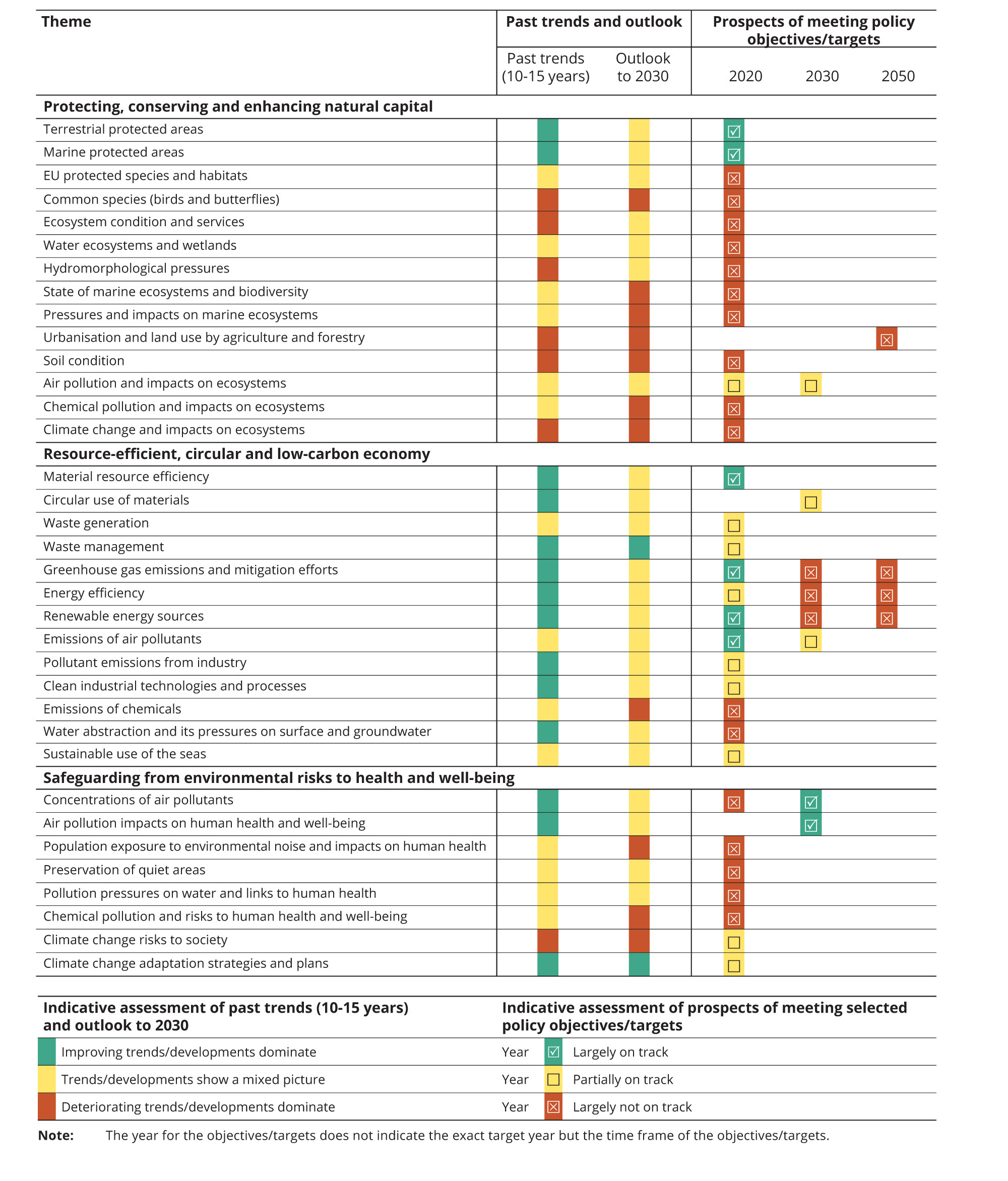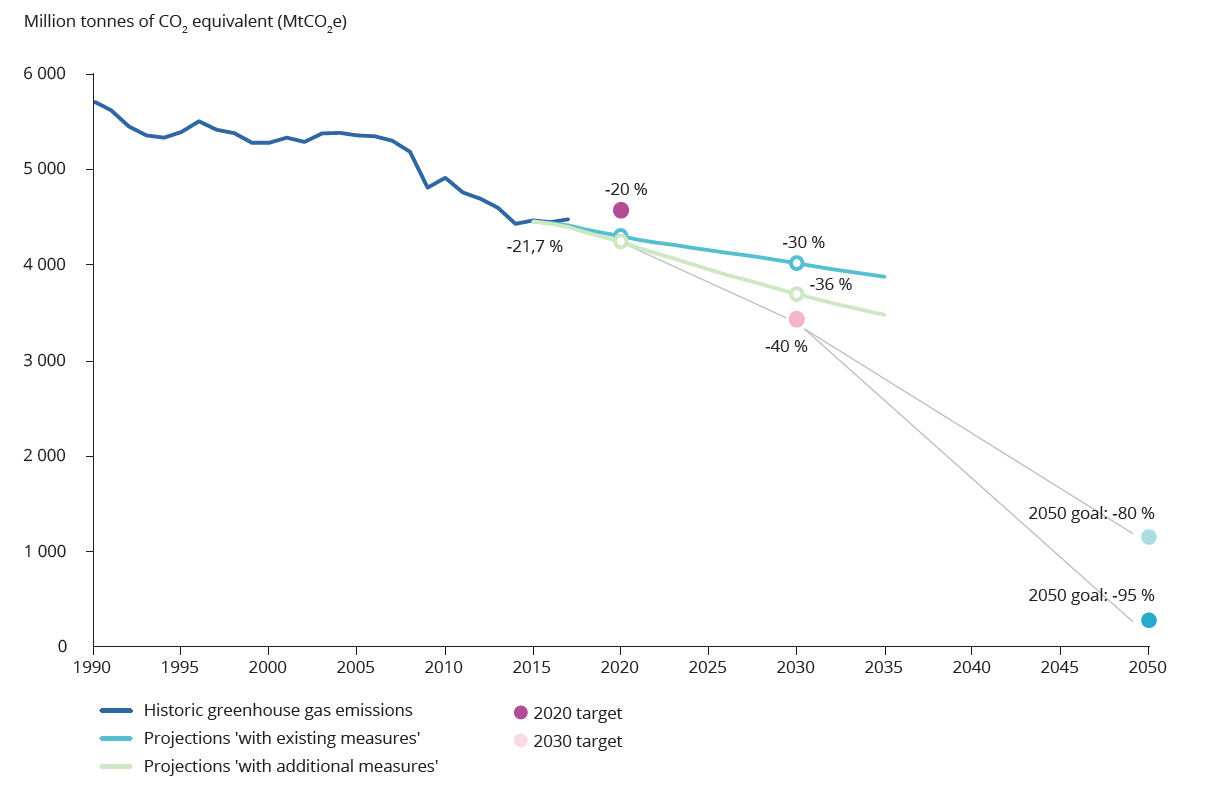While European environment and climate policies have helped to improve the environment over recent decades, Europe is not making enough progress and the outlook for the environment in the coming decade is not positive, according to the ‘European environment — state and outlook 2020 (SOER 2020)’ report.
SOER 2020 is the most comprehensive environmental assessment ever undertaken on Europe. It provides a stark snapshot of where Europe stands in meeting 2020 and 2030 policy targets as well as longer term 2050 goals and ambitions to shift to a sustainable, low carbon future. The report notes that Europe has already made significant progress over the past two decades in terms of climate change mitigation, reducing greenhouse gas emissions. Signs of progress are also evident in other areas, such as tackling air and water pollution and the introduction of new policies to tackle plastic waste and bolster climate change adaptation and the circular and bio-economy. Furthermore, the EU’s sustainable finance initiative is the first of its kind on the role of the financial sector in driving the necessary shift to a sustainable future.
Urgent call for scaling up and speeding up change
While these achievements are significant, Europe will not achieve its sustainability vision of ‘living well within the limits of the planet’ by continuing to promote economic growth and seeking to manage the environmental and social impacts. The report urges European countries, leaders and policymakers to seize the opportunity and use the next decade to radically scale up and speed up actions to put Europe back on track to meeting its medium and longer-term environmental policy goals and targets to avoid irreversible change and damage.
The current range of European policy actions provide an essential foundation for future progress but they are not enough. Europe needs to do things better, it needs to address certain challenges differently, and it needs to rethink its investments. Achieving Europe’s goals will require better implementation and improved coordination between current policies. It will also need additional policy actions to achieve fundamental change in the key systems of production and consumption that underpin our modern lifestyles, such as food, energy and mobility, which have substantial environmental impacts.
The report also stresses the importance of how governments can enable a transition to sustainability and the need to address things differently. For example, Europe should rethink how it uses existing innovations and technologies, how production processes could be improved, how research and development into sustainability could be fostered and how changes in consumption patterns and ways of living could be stimulated.
Lastly, achieving such change will require investing in a sustainable future and stopping using public funds to subsidise environmentally damaging activities. Europe will gain immensely from such a change in investment priorities because of the economic and social opportunities that it can create. At the same time, it will be crucial to listen to public concerns and ensure widespread support for such a shift — a socially fair transition.
The State of the Environment Report is perfectly timed to give us the added impetus we need as we start a new five-year cycle in the European Commission and as we prepare to present the European Green Deal.
In the next five years we will put in place a truly transformative agenda, rolling out new clean technologies, helping citizens to adapt to new job opportunities and changing industries, and shifting to cleaner and more efficient mobility systems and more sustainable food and farming.
There will be multiple benefits for Europe and for Europeans if we get this right, and our economy and our planet will be winners too. This is an urgent global challenge, and a unique opportunity for Europe.
Frans Timmermans, Executive Vice President of the European Commission.
‘Europe’s environment is at a tipping point. We have a narrow window of opportunity in the next decade to scale up measures to protect nature, lessen the impacts of climate change and radically reduce our consumption of natural resources. Our assessment shows that incremental changes have resulted in progress in some areas but not nearly enough to meet our long-term goals. We already have the knowledge, technologies and tools we need to make key production and consumption systems such as food, mobility and energy sustainable. Our future well-being and prosperity depend on this and our ability to harness society wide action to bring about change and create a better future,’ said Hans Bruyninckx, EEA Executive Director.
The state of the environment has worsened, outlook is mixed
Overall environmental trends in Europe have not improved since the last EEA state of the environment report in 2015. The assessment notes that while most of the 2020 targets will not be achieved, especially those on biodiversity, there is still a chance to meet the longer-term goals and objectives for 2030 and 2050.
Europe has made important gains in resource efficiency and the circular economy. But recent trends highlight a slowing down of progress in areas such as reducing greenhouse gas emissions, industrial emissions, waste generation, improving energy efficiency and the share of renewable energy. Looking ahead, the current rate of progress will not be enough to meet 2030 and 2050 climate and energy targets.
Protecting and conserving European biodiversity and nature remains the biggest area of discouraging progress. Of the 13 specific policy objectives set for 2020 in this area, only two are likely be met: designating marine protected areas and terrestrial protected areas. Looking ahead to 2030, if current trends continue, they will result in further deterioration of nature and continued pollution of air, water and soil.
Climate change, air and noise pollution impacts on the environment and human health are also still of concern. Exposure to fine particulate matter is responsible for around 400 000 premature deaths in Europe every year, affecting central and eastern European countries disproportionally. There is also growing concern over hazardous chemicals and the risks they pose. Looking ahead, the prospects for reducing environmental risks to health would be improved with better integration of environment and health policies.

Greenhouse gas emission trends and projections in the EU-28, 1990-2050

Note: The GHG emission trends, projections and target calculations include emissions from international aviation, and exclude emissions and removals from the LULUCF sector. The ‘with existing measures’ scenario reflects existing policies and measures, whereas the ‘with additional measures’ scenario considers the additional effects of planned measures reported by Member States.
Source: SOER 2020 p.158. Based on the final 2019 EU GHG inventory submission to the United Nations Framework Convention on Climate Change and projections reported by EU Member States under the EU Monitoring Mechanism Regulation.
A sustainable future is still possible: where to take action?
Achieving Europe’s low carbon and sustainability vision is still possible. The report outlines seven key areas where bold action is needed to get Europe back on track to achieve its 2030 and 2050 goals and ambitions.
- Realise the unfulfilled potential of existing environmental policies. Fully implementing existing policies would take Europe a long way to achieving its environmental goals up to 2030.
- Embrace sustainability as the framework for policy making. Developing long-term policy frameworks with binding targets — starting with the food system, chemicals and land use — will stimulate and guide coherent actions across policy areas and society.
- Lead international action towards sustainability. The EU should use its diplomatic and economic influence to promote the adoption of ambitious international agreements in areas such as biodiversity and resource use.
- Foster innovation throughout society. Changing the current trajectory will closely depend on the emergence and spread of diverse forms of innovation that can trigger new ways of thinking and living.
- Scale up investments and reorient the finance sector to support sustainable projects and businesses.This requires investing in the future by making full use of public funds to support innovation and nature-based solutions, procuring sustainably and supporting impacted sectors and regions. It also entails engaging the financial sector in sustainable investment by implementing and building on the EU’s Sustainable Finance Action Plan.
- Manage risks and ensure a socially fair transition. A successful transition to sustainability will require that societies acknowledge potential risks, opportunities and trade-offs, and devise ways to manage them. EU and national policies have an essential role in achieving ‘just transitions’ making sure no one is left behind.
- Build more knowledge and know-how. This entails additional focus on understanding the systems driving environmental pressures, pathways to sustainability, promising initiatives and barriers to change. Further capacity-building is needed to navigate a rapidly changing world by investing in education and skills.
The European environment – state and outlook 2020 is published by the EEA every five years as mandated in its regulation. SOER 2020 is the 6th SOER published by the EEA since 1995. It offers solid, science-based insights on how we must respond to the huge and complex challenges we face, such as climate change, biodiversity loss and air and water pollution.
SOER 2020 has been prepared in close collaboration with the EEA’s European Environment Information and Observation Network (Eionet). The report draws on the Eionet’s vast expertise of leading experts and scientists in the environmental field, across the EEA’s 33 member countries and six cooperating countries.